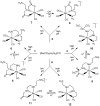Coordination modes of multidentate ligands in fac-[Re(CO)(3)(polyaminocarboxylate)] analogues of (99m)Tc radiopharmaceuticals. dependence on aqueous solution reaction conditions
- PMID: 20201565
- PMCID: PMC2861859
- DOI: 10.1021/ic9017568
Coordination modes of multidentate ligands in fac-[Re(CO)(3)(polyaminocarboxylate)] analogues of (99m)Tc radiopharmaceuticals. dependence on aqueous solution reaction conditions
Abstract
We study Re analogues of (99m)Tc renal agents to interpret previous results at the (99m)Tc tracer level. The relative propensities of amine donors versus carboxylate oxygen donors of four L = polyaminocarboxylate ligands to coordinate in fac-[Re(I)(CO)(3)L](n) complexes were assessed by examining the reaction of fac-[Re(I)(CO)(3)(H(2)O)(3)](+) under conditions differing in acidity and temperature. All four L [N,N-bis-(2-aminoethyl)glycine (DTGH), N,N-ethylenediaminediacetic acid, diethylenetriamine-N-malonic acid, and diethylenetriamine-N-acetic acid] can coordinate as tridentate ligands while creating a dangling chain terminated in a carboxyl group. Dangling carboxyl groups facilitate renal clearance in fac-[(99m)Tc(I)(CO)(3)L](n) agents. Under neutral conditions, the four ligands each gave two fac-[Re(I)(CO)(3)L](n) products with HPLC traces correlating well with known traces of the fac-[(99m)Tc(I)(CO)(3)L](n) mixtures. Such mixtures are common in renal agents because the needed dangling carboxyl group can compete for a coordination site. However, the HPLC separations needed to assess the biodistribution of a single tracer are impractical in a clinical setting. One goal in investigating this Re chemistry is to identify conditions for avoiding this problem of mixtures in preparations of fac-[(99m)Tc(I)(CO)(3)L](n) renal tracers. After separation and isolation of the fac-[Re(I)(CO)(3)L](n) products, NMR analysis of all products and single crystal X-ray crystallographic analysis of both DTGH products, as well as one product each from the other L, allowed us to establish coordination mode unambiguously. The product favored in acidic conditions has a dangling amine chain and more bound oxygen. The product favored in basic conditions has a dangling carboxyl chain and more bound nitrogen. At the elevated temperatures used for simulating tracer preparation, equilibration was facile (ca. 1 h or less), allowing selective formation of one product by utilizing acidic or basic conditions. The results of this fundamental study offer protocols and guidance useful for the design and preparation of fac-[(99m)Tc(I)(CO)(3)L](n) agents consisting of a single tracer.
Figures







Similar articles
-
Structure and Properties of fac-[Re(I)(CO)3(NTA)](2-) (NTA(3-) = Trianion of Nitrilotriacetic Acid) and fac-[Re(I)(CO)3(L)](n-) Analogues Useful for Assessing the Excellent Renal Clearance of the fac-[(99m)Tc(I)(CO)3(NTA)](2-) Diagnostic Renal Agent.Inorg Chem. 2015 Jul 6;54(13):6281-90. doi: 10.1021/acs.inorgchem.5b00584. Epub 2015 Jun 12. Inorg Chem. 2015. PMID: 26068141 Free PMC article.
-
Re(CO)(3) complexes synthesized via an improved preparation of aqueous fac-[Re(CO)(3)(H(2)O)(3)](+) as an aid in assessing (99m)Tc imaging agents. Structural characterization and solution behavior of complexes with thioether-bearing amino acids as tridentate ligands.Inorg Chem. 2005 Jul 25;44(15):5437-46. doi: 10.1021/ic0501869. Inorg Chem. 2005. PMID: 16022542
-
Complexes having the fac-[M(CO)3]+ core (M=Tc, Re) useful in radiopharmaceuticals: X-ray and NMR structural characterization and density functional calculations of species containing two sp3 N donors and one sp3 O donor.Inorg Chem. 2004 Nov 29;43(24):7774-83. doi: 10.1021/ic049544i. Inorg Chem. 2004. PMID: 15554642
-
pH-controlled coordination mode rearrangements of "clickable" Huisgen-based multidentate ligands with [M(I)(CO)3]+ (M = Re, (99m)Tc).Inorg Chem. 2013 Mar 18;52(6):2939-50. doi: 10.1021/ic302330u. Epub 2013 Mar 4. Inorg Chem. 2013. PMID: 23458126
-
Rhenium analogues of promising renal imaging agents with a [99mTc(CO)3]+ core bound to cysteine-derived dipeptides, including lanthionine.Inorg Chem. 2007 Apr 16;46(8):3385-94. doi: 10.1021/ic0619299. Epub 2007 Mar 22. Inorg Chem. 2007. PMID: 17375908
Cited by
-
fac-99mTc/Re-tricarbonyl complexes with tridentate aminocarboxyphosphonate ligands: suitability of the phosphonate group in chelate ligand design of new imaging agents.Inorganica Chim Acta. 2019 Feb 24;486:529-537. doi: 10.1016/j.ica.2018.11.012. Epub 2018 Nov 10. Inorganica Chim Acta. 2019. PMID: 30804606 Free PMC article.
-
New monodentate amidine superbasic ligands with a single configuration in fac-[Re(CO)3(5,5'- or 6,6'-Me2bipyridine)(amidine)]BF4 complexes.Inorg Chem. 2012 Jul 2;51(13):7271-83. doi: 10.1021/ic300625n. Epub 2012 Jun 12. Inorg Chem. 2012. PMID: 22691073 Free PMC article.
-
Design and synthesis of a bombesin peptide-conjugated tripodal phosphino dithioether ligand topology for the stabilization of the fac-[M(CO)3]+ core (M=(99 m)Tc or Re).Inorg Chem. 2011 Jul 4;50(13):6210-9. doi: 10.1021/ic200491z. Epub 2011 May 18. Inorg Chem. 2011. PMID: 21591746 Free PMC article.
-
Structure and Properties of fac-[Re(I)(CO)3(NTA)](2-) (NTA(3-) = Trianion of Nitrilotriacetic Acid) and fac-[Re(I)(CO)3(L)](n-) Analogues Useful for Assessing the Excellent Renal Clearance of the fac-[(99m)Tc(I)(CO)3(NTA)](2-) Diagnostic Renal Agent.Inorg Chem. 2015 Jul 6;54(13):6281-90. doi: 10.1021/acs.inorgchem.5b00584. Epub 2015 Jun 12. Inorg Chem. 2015. PMID: 26068141 Free PMC article.
-
Monoanionic 99mTc-tricarbonyl-aminopolycarboxylate complexes with uncharged pendant groups: Radiosynthesis and evaluation as potential renal tubular tracers.Nucl Med Biol. 2017 Apr;47:48-55. doi: 10.1016/j.nucmedbio.2016.12.008. Epub 2016 Dec 27. Nucl Med Biol. 2017. PMID: 28110124 Free PMC article.
References
-
- Richards P. In: Technetium in Chemistry and Nuclear Medicine 3. Nicolini M, Bandoli G, Mazzi U, editors. Cortina International; Verona, Italy: 1990. pp. 5–9.
-
- Bandoli G, Dolmella A, Porchia M, Refosco F, Tisato F. Coord. Chem. Rev. 2001;214:43–90.
-
- Lipowska M, Cini R, Tamasi G, Xu X, Taylor AT, Marzilli LG. Inorg. Chem. 2004;43:7774–7783. - PubMed
-
- He H, Lipowska M, Xu X, Taylor AT, Carlone M, Marzilli LG. Inorg. Chem. 2005;44:5437–5446. - PubMed
Publication types
MeSH terms
Substances
Grants and funding
LinkOut - more resources
Full Text Sources
Miscellaneous

